How do air purifiers work?
A device that filters the air to remove impurities and pollutants is an appealing prospect, but how exactly do air purifiers work?

Domestic air purifiers are becoming increasingly popular — and for good reason. Indoor air can have up to five times higher levels of pollutants than the air outdoors, according to the U.S. Environmental Protection Agency. Investing in a device that removes dust, allergens, harmful chemicals and other unwanted airborne particles seems like a no-brainer. But exactly how do air purifiers work?
Most air purifiers have a relatively simple setup: a fan that sucks in air, and one or more filters. These filters — usually made from paper, fibers such as fiberglass, or a mesh — capture particles as air passes over them, before the clean air is recirculated into the living space. However, all air purifiers are not created equal.
Significant differences exist between the different types of air purifier available on the market, and some devices may be more effective than others for people with allergies and respiratory conditions, Dr. Angela Hogan, chair of the American College of Allergy, Asthma and Immunology Asthma Committee, told Live Science by email.
To start with, the type of filters used in an air purifier will largely determine how much particulate matter it can pull out of the air. According to the National Library of Medicine, most air filters fall into three categories. Primary filters trap relatively large, coarse molecules measuring 5 microns or more, such as dust and pollen. Second-stage filters remove particles between 0.5 and 5 microns in diameter, which can include dust mite allergens and pet dander. High Efficiency Particulate Air (HEPA) filters, on the other hand, can remove at least 99.97% of particulates measuring 0.3 microns.
"In general, HEPA filters are considered the most effective [for trapping airborne allergens]," Hogan said. This is why they are a key feature in many of the best air purifiers on the market. However, it is important to note that results can vary even when using these high-efficiency filters, said Hogan.

The effectiveness of an air purifier can also be affected by other factors. The Clean Air Delivery Rate (CADR) is a good example. This metric is used to measure how much clean air an air purifier can produce in a set amount of time and space, and largely depends on the surface area of the filter and the strength of the fan. Generally, the higher the CADR, the more powerful the device.
It is also worth noting that many air purifiers come with additional pollutant-busting features, such as UV-C light sterilization — which brings us to medical-grade air purifiers.
Get the world’s most fascinating discoveries delivered straight to your inbox.
Medical-grade air purifiers are used in clinical and hospital settings where protecting at-risk patients from airborne pathogens and allergens is a top priority, Hogan said. "They must meet stringent standards and are considerably more expensive than regular consumer models. These devices can clean large volumes of air quickly and often incorporate multiple layers of filtration, including HEPA filters, activated carbon filters, UV-C light sterilization, and sometimes even ionizers," she said.
Ultraviolet light is used to destroy biological impurities such as mold and bacteria, while activated carbon filters are designed to remove gases like volatile organic compounds (VOCs) and smoke particles. That said, these features are becoming increasingly common in domestic air purifiers, too.

But what if you can't get hold of an air purifier? Could you make your own? Actually yes; all you need is a box fan and a HEPA or high-quality filter. There are two types of air purifiers you could make: the first uses a fan and one filter, while the second, which is a bit more complex to construct, uses a double filter set up over the fan.
These homemade air purifiers work in the same way as manufactured devices, and are fairly effective, with The New York Times and Los Angeles Times both having made and tested their own versions. Research from the Agency for Science, Technology, and Research (A*STAR) in Singapore considered different filter materials for their DIY air purifiers, including HEPA filters, surgical masks and melt-blown polypropylene. They found each material was around 80% effective at filtering particles and aerosols.
However, box fans are not designed for this purpose, and their motor has to work much harder to pull air through a filter, so these homemade air purifiers present an increased fire risk and should be used with caution.
So to answer our original question, air purifiers work by trapping most pollutants and allergens — but some will always remain in the air. Therefore, air purifiers are best used not by themselves, but to complement other air quality improvement strategies, such as increased cleaning, cleaning with eco-friendly products to reduce irritants, using indoor plants to help with air quality, and improving ventilation in the home.
This article is for informational purposes only and is not meant to offer medical advice.
Kerry is a freelance writer and editor, specializing in science and health-related topics. Her work has appeared in many scientific and medical magazines and websites, including Forward, Patient, NetDoctor, YourWeather, the AZO portfolio, and NS Media titles.
Kerry’s articles cover a wide range of topics including astronomy, nanotechnology, physics, medical devices, pharmaceuticals and mental health, but she has a particular interest in environmental science, cleantech and climate change.
Kerry is NCTJ trained, and has a degree Natural Sciences from the University of Bath where she studied a range of topics, including chemistry, biology, and environmental sciences.
- Anna GoraHealth Writer



